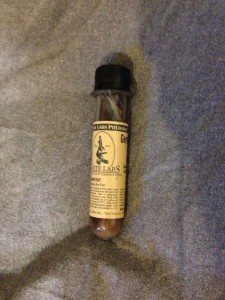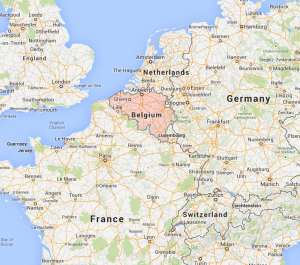This is the second article in a series on IPA variants, that started with darkish IPAs.
The beers of Belgium have inspired many US brewers. In turn, the hoppy ales of the United States have likewise inspired some Belgian brewers to formulate hoppier beers. Urthel Hop-It and Houblon Chouffe were two of earliest and best-known Belgian IPAs. These brewers took their Belgian beers and added significantly more hops to them. American brewers also took their IPAs and started fermenting them with Belgian ale yeasts. Stone’s Cali-Belgique is one of the best-known examples of this.
If you’re interested in brewing a beer that is a hybrid between an American IPA and a Belgian beer, there are a couple things I can tell you to get you started. However, the interface between these two kinds of beer has only begun to be explored — there’s more to be learned than is certain now.
The Base Beer
The base beer for an American-IPA/Belgian-beer hybrid can be any strong, pale Belgian beer or any strong, pale American ale. (For that matter, you could start with a strong British style ale and make a beer that’s a mash up of a British IPA and a Belgian beer.) Belgian tripels, Belgian strong golden ales or any strong pale to amber Belgian base beer could work. The more hoppy you intend the IPA to be, the more dry the base beer should be. As you might expect, for an American-style Belgian IPA, the base beer is an American-style IPA.
American-style IPAs are usually around 6–7% ABV, but suitable Belgian beers may be stronger. (Urthel Hop-It, an “uphopped” tripel, is 9.5% ABV.) When brewing a hybrid IPA, you can pick any alcoholic strength you want, regardless of the base. For example, you could make a “weak” tripel and hop it, or make a stronger IPA base (similar to a double IPA). You have a wide target in terms of alcohol content.
Tripels, strong golden ales and IPAs all tend towards the dry end of the spectrum. To accentuate the hops, you’ll want to stick to that formula. For the most part, if you avoid adding over 5% specialty malts (especially crystal malts) to your grain bill, you should be fine. If you want to to ensure the beer is very dry, you can swap a portion of the pale malt with sugar. Recall that this is how tripels and double IPAs are usually brewed.
Hops
American-style IPAs typically feature citrusy American hops, such as Cascade, Centennial, and Amarillo. “Piney” hops, such as Simcoe, are also quite common. Belgian brewers use mostly European hops for their beers, but their IPAs may contain some American hops. As a homebrewer, you’re free to choose the hop varieties for your Belgian IPA. In practice, Belgian IPAs built on a Belgian base beer are more often hopped with European hops. Belgian IPAs based on an American-style IPA grain bill tend to be hopped with American hops, but there’s no need to let that limit your ideas.
The IBUs in an American-style IPA are usually at least 50, with a BU:GU ratio around 1 being common. (For example, an IPA starting at OG 1.060 would have 60 IBUs.) American-style Belgian IPAs tend to stick fairly closely to this range, although the yeast strain may mute the hops a bit compared to neutral American ale yeasts.
In general, regular Belgian beers are not very hoppy. As such, Belgian-brewed Belgian IPAs are often not very hoppy when judged by American standards. Although substantially more bitter than tripels or golden strong ales, they none-the-less don’t always reach into the IBU range that American brewers expect in an IPA. (For reference, the BJCP gives 40–70 IBUs for American IPAs.)
When brewing your own Belgian IPA, you can aim for anywhere in the broad range from “more than the regular Belgian beer” to the high end of the American IPA range, and choose whatever hop varieties you want.
Yeast Strains

The biggest hurdle to brewing a great Belgian IPA is melding the yeast character with the hop aroma. Both the yeast strain and fermentation conditions contribute to the character imparted by the yeast.
One thing these beers have in common is being fermented with Belgian yeast strains. In fact, the biggest challenge to brewing a good Belgian IPA is finding a yeast character that doesn’t clash with the hops. Pick a yeast strain that ferments dry, as many Belgian strains do. In addition, pick a strain which can produce a controlled amount of esters and spiciness, depending on how it is handled. For many Belgian strains, you can decrease the character of the yeast, having it tend more towards neutral, by increasing the pitching rate and not letting the fermentation run too warm. There are a lot of Belgian yeast strains out there. One I know works well for a Belgian IPA is the Westmalle strain, available to homebrewers as Wyeast 3687 (Trappist High Gravity) or White Labs WLP530 (Abbey Ale) yeast. With this yeast, the more yeast you pitch and the cooler you ferment (with in the usual ale fermentation range), the cleaner it becomes. If you have a favorite Belgian yeast strain, and you know how to manipulate its characteristics, give it a try.
Conclusion
So, essentially you can brew this beer as a Belgian beer inspired by American IPAs, or as an American IPA inspired by Belgian beers . . . or any mcombination of those two ideas. If you were to label it, you could potentially have a beer with “India,” “Belgium” and “America” all in the some name. In practice, these tend to be called simply Belgian IPAs.
I have yet to brew a beer like this, although my some friends of mine, the Dewberrys, have brewed an excellent version. Their recipe can be found here. If I brewed a Belgian IPA, I would probably call it Apu Goes to Belgium. (In the TV series The Simpsons, the character Apu Nahasapeemapetilon is of Indian descent, but becomes a US citizen.) If you brew a Belgian IPA, keep in mind that you have a lot of different options you can explore.
—
Related articles
High Temperature Belgian Yeast Strains


I think the problem with most American versions of this style is the lack of Belgian yeast character. Duvel’s most recent Tripel Hop with Sorachi Ace would be a great example of what works.
I also suggest rebranding the style as “Belginderica PA”. Just rolls of the tongue.
“Belginderica.” Nice. Maybe Urthel — who brewed the first (or at least the first widely known example of a) Belgian IPA — will insist that they be called Flanders Flowery Ales. (Urthel is in West Flanders.)
Where does the Belgian IPA (either American-style or Belgian-style) fit within BJCP guidelines? I assume this doesn’t fall into the IPA category (14) or the Belgian & French Ale (16) or Belgian Strong Ale (18). My guess is this would have to be a Specialty Beer (23)?
I don’t normally “restrict” my brewing habits to the BJCP guidelines, but I just happen to have two really good (in my opinion) Belgian IPA beers that I’m looking to submit to a local competition.
Cheers!
If you entered a Belgian IPA into BJCP category 14 (IPA), it would be judged to be out of style. Likewise, it doesn’t fit in any of the other established categories for Belgian beers.
In a BJCP contest, Belgian IPAs should be entered in category 23 (Specialty Beer). If it was an American-style IPA fermented with a Belgian yeast strain, label the beer as a Belgian IPA. If it’s an “uphopped” tripel or Belgian golden, I would label it to indicate this. For example, you could write “Belgian IPA (tripel base).”